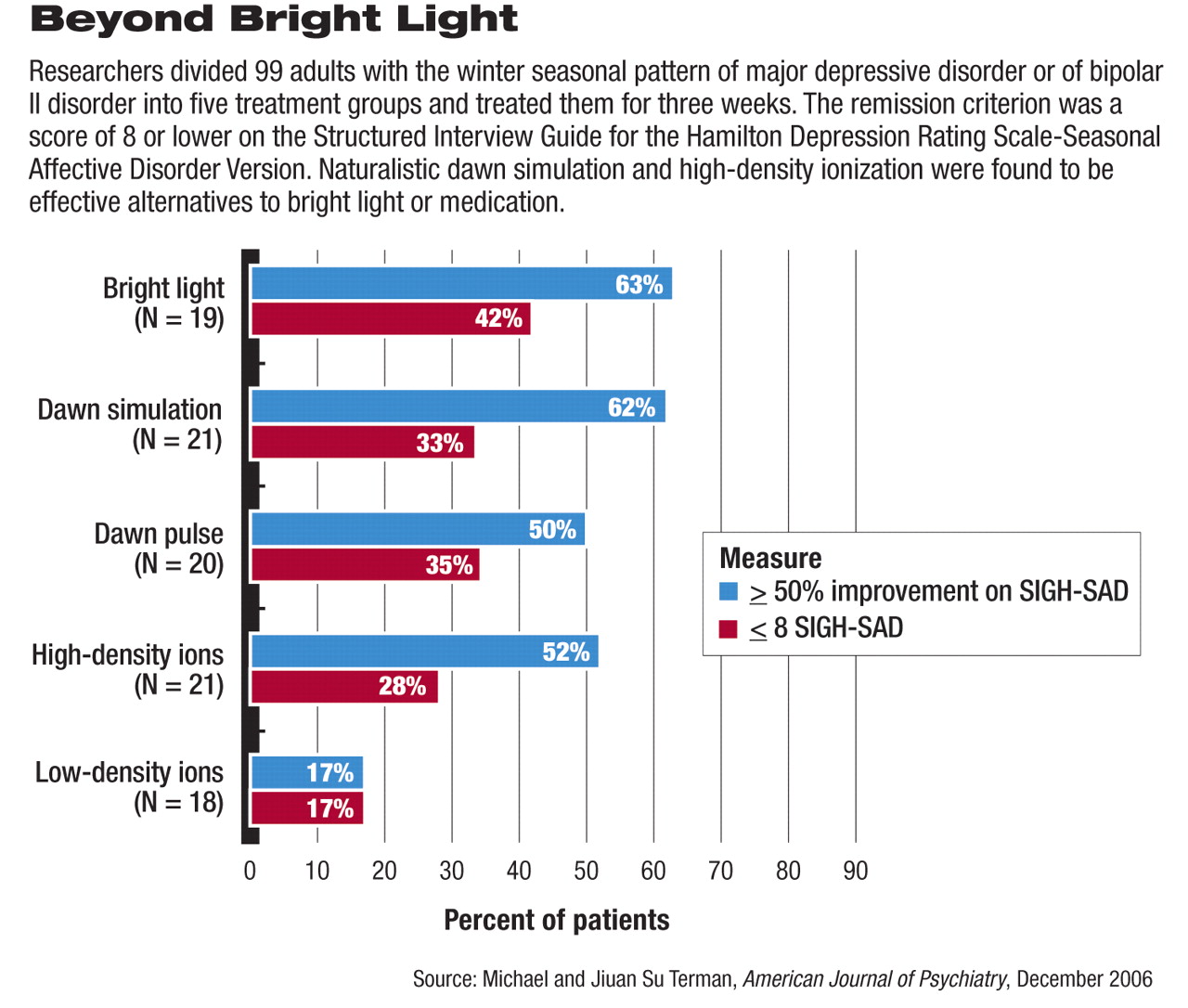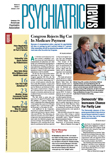Let the sun shine in! Or maybe not. Treatment options for seasonal affective disorder seem to be expanding—from antidepressants or bright-light therapy to exposure to a simulated dawn or negative air ionization.
One of the pioneers in this area is Michael Terman, Ph.D., director of the Center for Light Treatment and Biological Rhythms at Columbia University Medical Center and director of the Clinical Chronobiology Program at New York State Psychiatric Institute. A few years ago, Terman and several coworkers obtained preliminary evidence that a simulated dawn could reduce the symptoms of seasonal affective disorder. They then obtained evidence that high-density negative air ionization could have the same effect.
“We were seeking a plausible placebo control for light therapy—which, by definition, cannot be administered blind,” Terman told Psychiatric News. “There is an old pop literature on the mood-enhancing effects of negative air ions—think Niagara Falls—and the deleterious effect on mood when the balance [of ions] leans positive [as is the case] in dry, heated environments and indoor spaces with central air conditioning.”
With this in mind, a friend suggested that a disconnected electronic ionizer would work as well as a placebo because subjects would believe the method to be effective, yet could not directly sense the presence or absence of air ions. However, Michael Terman and his group decided to use real negative ions as a placebo instead. Much to their surprise, they found that high-density—but not low-density—negative air ionization can counter the symptoms of seasonal affective disorder.
In the past six years or so, Terman, along with Jiuan Su Terman, Ph.D., his wife and a research scientist in his Clinical Chronobiology Program, have been comparing the therapeutic values of negative air ionization and dawn simulation to those of a well-established treatment for seasonal affective disorder, bright-light exposure, as well as to the therapeutic value of another possible treatment for the malady, a pulse of dawn light. The nonprofit Center for Environmental Therapeutics, of which Michael Terman is president of the board, sells both light boxes and negative ion generators to the public.
Results from this investigation, published in the December 2006 American Journal of Psychiatry, suggested that high-density negative air ionization, dawn simulation, and a dawn pulse are as effective as bright-light exposure, but that low-density negative air ionization is not.
In the study, 99 adults with the winter seasonal pattern of major depressive disorder or of bipolar II disorder were split into five treatment groups and treated daily over a three-week period. The treatment conditions were exposure to bright light for half an hour after awakening, a simulated sunrise at wake-up time, a pulse of dawn light for 13 minutes before wakeup time, negative air ions for 93 minutes before wake-up time at a low flow rate with an inconsequential effect on air circulation, and negative air ions for 93 minutes before wake-up time at a high flow rate—or what Michael Terman called “an `industrial strength' flow rate, such as used in clean rooms.”
Subjects were assessed for depressive symptoms at the start of, during, and end of treatment. Outcomes for the five treatment groups were compared.
High-Density Ions Pass Test
The proportion of subjects who achieved a depression score reduction of 50 percent or more by the end of the study was statistically comparable for the bright light group, the dawn simulation group, the dawn pulse group, and the high-density ion group, but not for the low-density ion group (see chart). Thus, dawn simulation, high-density negative ionization, and dawn pulse appeared to be comparable to bright light in treating seasonal affective disorder, but low-density negative ionization was not.
Nonetheless, “Despite the superiority of the dawn pulse over low-density ions and lack of difference from other active treatments,” there was a distinct group of nonresponders in the dawn-pulse group. Thus, the Termans are reluctant to endorse dawn pulse as a treatment option for seasonal affective disorder.
In contrast, both dawn simulation and high-density negative ionization are comparable to bright light in treating seasonal affective disorder, they believe, and the choice of one therapy over the other “may depend on convenience and ease of compliance.”
For example, automated exposure to a simulated dawn or to negative air ions“ during sleep has an advantage over post-awakening bright light therapy,” Michael Terman explained.
“On the other hand, dawn presentation in the bedroom can disturb a sleep partner with a later wake-up time, whereas bright light therapy can be administered privately in a separate room. Negative air ionization during sleep appears to be the most innocuous alternative; thus far, we have received no reports of disturbance in bed partners.”
Building on Past Successes
“The Termans have been pioneers in the use of light therapies in the treatment of seasonal affective disorder,” David Avery, M.D., a professor of psychiatry at the University of Washington and a seasonal affective disorder expert, told Psychiatric News. “[They] developed the idea of using dawn simulation to treat seasonal affective disorder in the late 1980s and now have conducted a very well-designed study that further supports the efficacy of a dawn signal compared to a control condition.... The efficacy of the negative air ionization is intriguing and deserves further exploration.”
“The Termans are well known for their careful and rigorously conducted clinical studies,” Raymond Lam, M.D., a professor of psychiatry at the University of British Columbia and a seasonal affective disorder authority, added. “This is an important study that carefully assessed the therapeutic effects of dawn simulation, bright light, and high-density negative ions against a credible placebo condition (low-density negative ions) in patients with seasonal affective disorder. Although the sample size was quite small—about 20 patients per condition—they were able to show significant antidepressant effects of the active conditions over the three weeks of treatment.
“There has, regretfully, been less [commercial] interest than expected in these new noninvasive biological treatments,” Lam also commented. The reason, he indicated, is because there is no huge profit to be made from them as from, say, psychotropic medications.
The investigation was funded by the National Institutes of Health.

